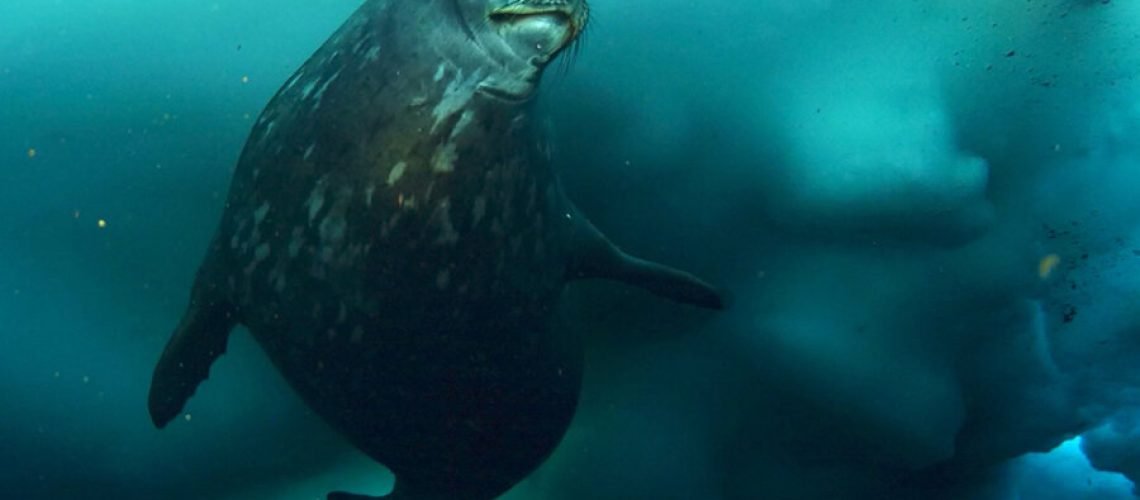When it comes to chilly polar sounds, it’s tough to top the incredible Antarctic Weddell seal. These creatures live in some of the most extreme conditions on Earth, above and below sea ice – and scientists are discovering more and more about their audible and inaudible vocalizations.
Even in the audible spectrum, the Weddell seals make some otherworldly trills and whistles. Researchers in 1982 described some 34 different types of calls just in the frequency range of human hearing.
The breakthrough discovery announced in 2020 was that Weddell seals also make ultrasonic calls – including when they’re under the polar ice, where they’re able to swim up to about 80 minutes on a single breath. Even the researchers thought of ARP synthesizers. (Okay, they’re not synth nerds, so they said “Star Wars” but – they’re not wrong.) Captured on a digital hydrophone, their ultransensitive broadband mic picked up high-pitched sounds that a standard mic (and our ears) missed.
Watch/listen (yep, I smashed that “subscribe” button – Antarctica me, please):
Not only that, but the team says the ultrasonic calls are used frequently. And the researchers got really excited, as evidenced by the video and these articles (worth reading, and very accessible to laypersons, speaking as someone who sadly did not pursue a childhood fantasy of oceonography):
UO team finds Weddell seals make unheard-of sounds [University of Oregon]
Inaudible Melodies – Weddell seals produce ultrasonic vocalizations! [McMurdo Oceanographic Observatory, Antractica]
Want the actual science writing? Here you go:
Weddell seals produce ultrasonic vocalizations [The Journal of the Acoustical Society of America … careful, seeing some of the attached links you might just subscribe]
Specifically, from the abstract – and while we may not all be seal nerds, we’re sound nerds, so we can read this (in case you want to calibrate your Eurorack for underwater Antarctic seal performances):
Nine recurrent call types were identified that were composed of single or multiple vocal elements whose fundamental frequencies spanned the ultrasonic range to nearly 50 kHz. Eleven vocal elements had ultrasonic center frequencies (≥20 kHz), including chirps, whistles, and trills, with two elements at >30 kHz. Six elements had fundamental frequencies always >21 kHz. The fundamental frequency of one repetitive U-shaped whistle element reached 44.2 kHz and descending chirps (≥3.6 ms duration) commenced at ≤49.8 kHz. The source amplitude of one fully ultrasonic chirp element (29.5 kHz center frequency) was 137 dB re 1 μPa-m. Harmonics of some vocalizations exceeded 200 kHz. Ultrasonic vocalizations occurred throughout the year with the usage of repetitive ultrasonic chirp-based calls appearing to dominate in winter darkness. The functional significance of these high-frequency vocalizations is unknown.


If it just seems like this is a completely off-topic side-trip into oceanography and random seal footage, it’s … well, it is definitely that, but not only that.
This question of what the researchers missed – and how the seals communicate – demonstrates how anthropocentric our definition of sound really is. Many dictionary definitions of sound even determine sound not only by characterizing their vibrations but by those vibrations being audible in human hearing. Since not all human hearing is the same, that created a logical quandary of the “tree falling in the forest” variety – does that mean as our hearing ages and we lose parts of the spectrum sound ceases to exist, for instance?
Here’s a case where technology can open our perception; the researchers benefited from a mic that had a frequency spectrum greater than their hearing. And it should be clear that the “seal” definition of sound would be broader than ours. This also has relevance in quantum physics; as I wrote a few years ago, we might soon redefine sound around other forms of waves, as with gravitational waves, especially as technology is able to translate those into our human perception.
Reorienting culture, philosophy, and design beyond human-centered frames was an ongoing thread at this month’s Fiber Festival in Amsterdam. Researcher Colette Aliman specifically spoke to this question of non-human sounds and communication, and reminded me of the Weddell seals as an example. Also featured at Fiber and well worth checking out – see the Queer Ecology collective / research on similar directions.
With the Weddell seals, though, you also see some potential for musicians and sound synthesists to aid in translating animal sounds to human hearing and even actively engaging in forms of sound production and perception that previously were impossible for humans. That’s a conversation I hope we do have, particularly as our planet enters a crescendo of crises.
Photo credits: Michael Lucibella / McMurdo Oceanographic Observatory.
Oh, PS, McMurdo’s livestream is off the air, but they still do some streaming events. I want that more than DJ streams, for sure.
Want more seal sounds? Well, the researchers say they fell asleep listening to these; bet we can, too.
Sounds wild even above-ground in human-audible ranges:




